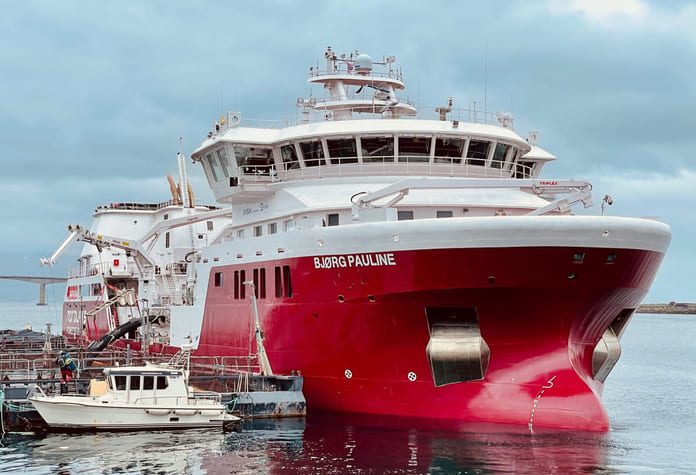Employee contributions worth gold.
The 84m long and 19m wellboat is docked at salmon producer Nordlaks’ facility on Børøya in Vesterålen, Northern Norway. Rainbow trout from their own facilities are en route to the waiting cages.
As the very first guest, SalmonBusiness was invited aboard “Bjørg Pauline” to join a tour together with Nordlaks’ wellboat manager Kurt Werner Nilsen.

Delivered from the Turkish shipyard Tersan Ship Yard, just over a year late because of Covid, “Bjørg Pauline” arrived at her home port on the evening of 3 May, after a trip of 19 days.

“A great boat that is very good at sea. Way above our expectations. Compared to before, there are two vastly different boats,” said Ellingsen.
A very pleased Captain Jim Rainer Ellingsen on “Bjørg Pauline”
“It’s hard to get seasick on board,” said the captain.
“The chef could cook every day. That’s how well the trip went,” he said.
On the bridge, Ellingsen holds his finger firmly on the right control button. The waiting cages are filled with rainbow trout.
The trout has a gutted weight of 3.8 kilograms. Now there are a total of 115 tonnes gutted weight leaving “Bjørg Pauline”. The capacity is 600 tonnes of live fish, with space for 4,200m3 of water. The job of today’s mission takes around three hours of loading and unloading.

Kurt Werner Nilsen has not sailed a wellboat since it was 50ft. He had been looking forward to picking up “Bjørg Pauline” in Turkey. Unfortunately, COVID put an end to that. He has been with Nordlaks since 1990, as one of two permanent fish farm operators at the time.
“Onboard there is significantly more technology for monitoring and control. We have spent a lot of energy and money and done better,” said Nilsen.
With a triplex crane package and Cflow fisheries package, it is equipped for loading/unloading at exposed aquaculture facilities.
“Very early in the process, they picked out a captain and a chief engineer from the old boat to contribute,” said Nilsen. It was Captain Per Tore Paulsen and Chief Engineer Svein Arild Jakobsen.
“They have participated actively in drawing and planning. Employees have been involved in deciding, since they know where the shoe presses through their long-standing experience,” said Kurt Werner Nilsen.

“We added to the team, Captain Sten Gustav Eide, Chief Engineer Kjell Arne Sommerseth and Chief Superintendent Sverre Nilsen in due course. They have a tremendous amount of experience in the crews we have. The contribution was worth gold,” Nilsen said.
The coffee shop for itself
On board is the coffee shop only for the crew. Previously, it was common to both customers and crew. Nilsen believes it is important to shield people when they are off duty.

It is not only rest, peace and quiet that awaits the crew of the free guard. A well-equipped gym is ready. Therefore, no need not to pump iron, to keep the muscles intact until heavy lifting aboard “Bjørg Pauline”.

Through the fair are trips to the galley, which is stowed Arne Tobiasen’s kingdom.
The galley is larger and provides better elbow room. The chef is preparing the meal for the day, a delicious Fish Au Gratin for dinner, and a Turkish lamb stew for supper.

The motor boys
In the control room, we meet Chief Engineer Finn Liland. He is busy in conversations with a supplier, but we get to exchange a few words with the engine apprentice, Simen Olsen.

He sits and reads when we note that he is still only on page one of the manual. Olsen laughs and explains that he has read it before. Right now, he’s looking for something he was just going to check again, is his explanation on page one.
Down in the engine compartment, there is little noise. Four engines lean burn generator sets are responsible for moving.
On the fish handling deck, it is completely dry.
“The three-way valves have not been made in such large dimensions before they were installed in “Bjørg Pauline”. We trust them to function well in relation to fish welfare. There are a total of nine valves,” said Kurt Werner Nilsen.

The 700 kilowatt battery pack is used to remove the peaks when power is urgently needed. This way they avoid starting up the engines to just pick up some juice.
The boat has an SFI mechanical delousing system, and a Norwater RO facility that can provide well over 5,000m3 of fresh water a day.

“Bjørg Pauline” is named after Nordlaks founder Inge Berg’s mother. When the previous boat of the same name was sold to Intership, the clause was that the name remained with Nordlaks. Her journey thus continues along the northern Norwegian coast.


